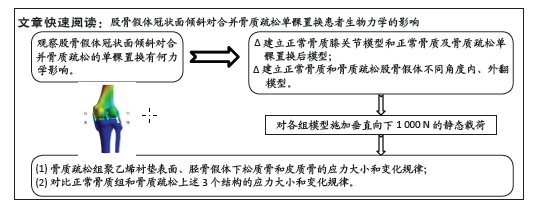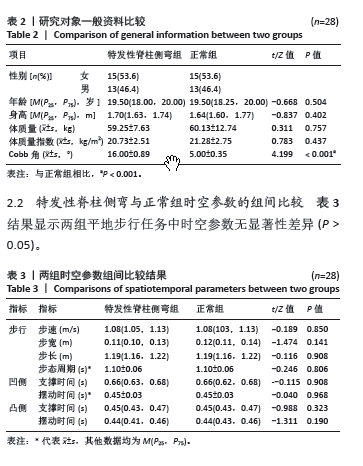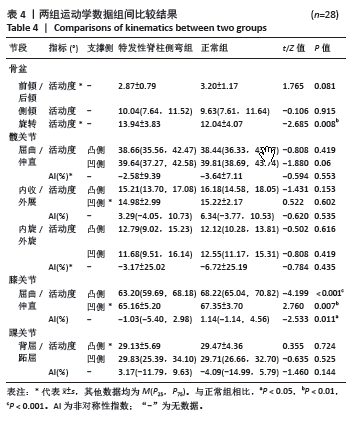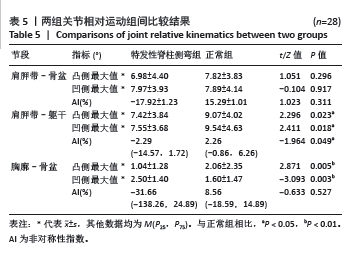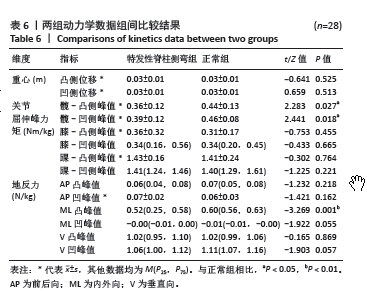[1] NEGRINI S, DONZELLI S, AULISA AG, et al. 2016 SOSORT guidelines: orthopaedic and rehabilitation treatment of idiopathic scoliosis during growth. Scoliosis Spinal Disord. 2018;13:3.
[2] NEGRINI S, AULISA AG, AULISA L, et al. 2011 SOSORT guidelines: orthopaedic and rehabilitation treatment of idiopathic scoliosis during growth. Scoliosis. 2012;7(1):3.
[3] 彭舜华,熊毅.某医专新生脊柱侧弯患病率调查及情况分析[J].科教导刊-电子版(下旬),2020(3):297.
[4] 金雄哲,朴正汉,孙成哲.大学体育课中对大学生脊柱侧弯的调查研究[J].体育风尚,2019(11):117-118.
[5] PARK HJ, SIM T, SUH SW, et al. Analysis of coordination between thoracic and pelvic kinematic movements during gait in adolescents with idiopathic scoliosis. Eur Spine J. 2016;25(2):385-393.
[6] PIALASSE JP, DESCARREAUX M, MERCIER P, et al. The vestibular-evoked postural response of adolescents with idiopathic scoliosis is altered. PLoS One. 2015;10(11):e0143124.
[7] KIM DS, PARK SH, GOH TS, et al. A meta-analysis of gait in adolescent idiopathic scoliosis. J Clin Neurosci. 2020;81:196-200.
[8] 朱飞龙,张明,吴宇,等.青少年特发性脊柱侧弯患者足部姿势和步态特征的3D形态分析及生物力学评价[J].中国组织工程研究,2021, 25(33):5294-5300.
[9] HABER CK, SACCO M. Scoliosis: lower limb asymmetries during the gait cycle. Arch Physiother. 2015;5:4.
[10] GIAKAS G, BALTZOPOULOS V, DANGERFIELD PH, et al. Comparison of gait patterns between healthy and scoliotic patients using time and frequency domain analysis of ground reaction forces. Spine. 1996;21(19):2235-2242.
[11] SYCZEWSKA M, GRAFF K, KALINOWSKA M, et al. Influence of the structural deformity of the spine on the gait pathology in scoliotic patients. Gait Posture. 2012;35(2):209-213.
[12] DARYABOR A, ARAZPOUR M, SHARIFI G, et al. Gait and energy consumption in adolescent idiopathic scoliosis: a literature review. Ann Phys Rehabil Med. 2017;60(2):107-116.
[13] GIEYSZTOR EZ, SADOWSKA L, CHOIŃSKA AM, et al. Trunk rotation due to persistence of primitive reflexes in early school-age children. Adv Clin Exp Med. 2018;27(3):363-366.
[14] PESENTI S, PROST S, POMERO V, et al. Does static trunk motion analysis reflect its true position during daily activities in adolescent with idiopathic scoliosis? Orthop Traumatol Surg Res. 2020;106(7):1251-1256.
[15] XUN F, CANAVESE F, XU H, et al. Preliminary evaluation of sagittal and transverse plane cross-sectional variations of the trunk during quiet and deep breathing by optical reflective motion analysis in patients with scoliosis. J Pediatr Orthop B. 2022;31(1):78-86.
[16] STRUBER L, NOUGIER V, GRIFFET J, et al. Comparison of trunk motion between moderate AIS and healthy children. Children (Basel). 2022; 9(5):738.
[17] PESENTI S, PROST S, POMERO V, et al. Characterization of trunk motion in adolescents with right thoracic idiopathic scoliosis. Eur Spine J. 2019; 28(9):2025-2033.
[18] Society SR. Diagnosing Scoliosis. https://www.srs.org/patients-and-families/conditions-and-treatments/adolescents/diagnosing-scoliosis.
[19] PARK YS, LIM YT, KOH K, et al. Association of spinal deformity and pelvic tilt with gait asymmetry in adolescent idiopathic scoliosis patients: investigation of ground reaction force. Clin Biomech (Bristol, Avon). 2016;36:52-57.
[20] KRAMERS-DE QUERVAIN IA, MÜLLER R, STACOFF A, et al. Gait analysis in patients with idiopathic scoliosis. Eur Spine J. 2004;13(5):449-456.
[21] REZNICK E, EMBRY KR, NEUMAN R, et al. Lower-limb kinematics and kinetics during continuously varying human locomotion. Sci Data. 2021;8(1):282.
[22] PESENTI S, POMERO V, PROST S, et al. Curve location influences spinal balance in coronal and sagittal planes but not transversal trunk motion in adolescents with idiopathic scoliosis: a prospective observational study. Eur Spine J. 2020;29(8):1972-1980.
[23] WU G, SIEGLER S, ALLARD P, et al. ISB recommendation on definitions of joint coordinate system of various joints for the reporting of human joint motion--part I: ankle, hip, and spine. International Society of Biomechanics. J Biomech. 2002;35(4):543-548.
[24] CAPPOZZO A, CATANI F, CROCE UD, et al. Position and orientation in space of bones during movement: anatomical frame definition and determination. Clinical biomechanics (Bristol). 1995;10(4):171-178.
[25] THAKUR A, HEYER JH, WONG E, et al. The effects of adolescent idiopathic scoliosis on axial rotation of the spine: a study of twisting using surface topography. Children (Basel). 2022;9(5):670.
[26] SUNG PS, PARK MS. Asymmetrical thoracic-lumbar coordination during trunk rotation between adolescents with and without thoracic idiopathic scoliosis. Spine Deform. 2022;10(4):783-790.
[27] HOLEWIJN RM, DE KLEUVER M, KINGMA I, et al. A prospective analysis of motion and deformity at the shoulder level in surgically treated adolescent idiopathic scoliosis. Gait Posture. 2019;69:150-155.
[28] POUSSA M, MELLIN G. Spinal mobility and posture in adolescent idiopathic scoliosis at three stages of curve magnitude. Spine. 1992;17(7):757-760.
[29] POUSSA M, HÄRKÖNEN H, MELLIN G. Spinal mobility in adolescent girls with idiopathic scoliosis and in structurally normal controls. Spine. 1989; 14(2):217-219.
[30] WONG C. Mechanism of right thoracic adolescent idiopathic scoliosis at risk for progression; a unifying pathway of development by normal growth and imbalance. Scoliosis. 2015;10:2.
[31] BURWELL RG, COLE AA, COOK TA, et al. Pathogenesis of idiopathic scoliosis. The Nottingham concept. Acta Orthop Belg. 1992;58 Suppl 1:33-58.
[32] 张波波.青少年特发性脊柱侧弯与骨盆关系的研究进展[J].中国矫形外科杂志,2016,24(13):1198-1201.
[33] LAMOTH CJ, BEEK PJ, MEIJER OG. Pelvis-thorax coordination in the transverse plane during gait. Gait Posture. 2002;16(2):101-114.
[34] HADDAS R, JU KL, BELANGER T, et al. The use of gait analysis in the assessment of patients afflicted with spinal disorders. Eur Spine J. 2018;27(8):1712-1723.
[35] MAHAUDENS P, BANSE X, MOUSNY M, et al. Gait in adolescent idiopathic scoliosis: kinematics and electromyographic analysis. Eur Spine J. 2009; 18(4):512-521.
[36] WU KW, WANG TM, HU CC, et al. Postural adjustments in adolescent idiopathic thoracic scoliosis during walking. Gait Posture. 2019;68:423-429.
[37] PARK Y, KO JY, JANG JY, et al. Asymmetrical activation and asymmetrical weakness as two different mechanisms of adolescent idiopathic scoliosis. Sci Rep. 2021;11(1):17582.
[38] YANG JH, SUH SW, SUNG PS, et al. Asymmetrical gait in adolescents with idiopathic scoliosis. Eur Spine J. 2013;22(11):2407-2413.
[39] NAULT ML, ALLARD P, HINSE S, et al. Relations between standing stability and body posture parameters in adolescent idiopathic scoliosis. Spine. 2002;27(17):1911-1917.
[40] MALLAU S, BOLLINI G, JOUVE JL, et al. Locomotor skills and balance strategies in adolescents idiopathic scoliosis. Spine. 2007;32(1):E14-E22.
[41] BRUYNEEL AV, CHAVET P, BOLLINI G, et al. Lateral steps reveal adaptive biomechanical strategies in adolescent idiopathic scoliosis. Ann Readapt Med Phys. 2008;51(8):630-635.
|
